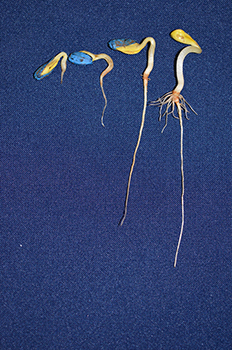Eighty-six percent of South Africa’s
sunflowers are produced in the
Free State and North West provinces.
Helen Mirren, the English actress, said “the sunflower is like a satellite dish for sunshine”. However, researchers at the University of the Free State (UFS) have found that too much of this sunshine could have a negative effect on the growth of sunflowers, which are a major source of oil in South Africa.
According to Dr Gert Ceronio from the Department of Soil, Crop, and Climate Sciences at the UFS, extremely high soil temperatures play a definite role in the sprouting of sunflower seedlings. Together with Lize Henning, professional officer in the department, and Dr André Nel from the Agricultural Research Council, he is doing research on biotic and abiotic factors that could have an impact on sunflowers.

Various degrees of deformity (bad-left
to none-right) in seedlings of the same
cultivar at very high soil temperatures.
Photo: Dr Gert Ceronio
Impact of high temperatures on sunflower production
The Free State and North West provinces, which produce 86% of South Africa’s sunflowers, are afflicted especially by high summer temperatures that lead to extremely high soil temperatures.
Dr Ceronio says: “Although sunflower seeds are able to germinate at temperatures from as low as 4°C to as high as 41°C, soil temperatures of 35°C and higher could have a negative effect on the vegetative faculty of sunflower seedlings, and could have an adverse effect on the percentage of sunflowers that germinate. From the end of November until mid-January, this is a common phenomenon in the sandy soil of the Free State and North West provinces. Soil temperatures can easily exceed the critical temperature of 43°C, which can lead to poor germination and even the replanting of sunflowers.”
Since temperature have a huge impact not only on the germination of sunflower seeds, but also on the vegetative faculty and sprouting of sunflower seedlings, Dr Ceronio suggests that sunflowers should be planted in soil with soil temperatures of 22 to 30°C. Planting is usually done in October and early November. Unfortunately, this is not always possible, as soil moisture is not optimal for growth. Farmers are then compelled to plant sunflowers later.
Impact of herbicides on sunflower growth
“High soil temperatures, combined with the herbicide sensitivity of some cultivars, could lead to the poor development of seedlings," says Dr Ceronio.
The use of herbicides, such as ALACHLOR, for the control of weeds in sunflowers is common practice in sunflower production. It has already been determined that ALACHLOR could still have a damaging effect on the seedlings of some cultivars during germination and sprouting, even at recommended application dosages.
“The purpose of the continued research is to establish the sensitivity of sunflower cultivars to ALACHLOR when exposed to high soil temperatures,” says Dr Ceronio.